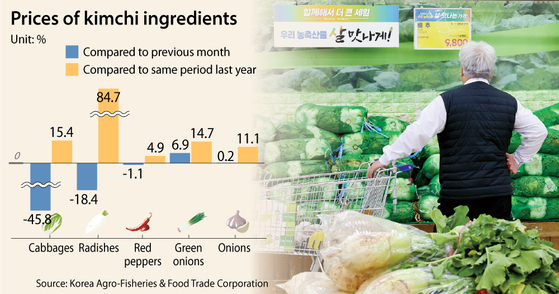Cabbage costs on a downhill roll, but Korean kimchi is still pricey

Although the price of napa cabbages appears to be rolling downhill, the price for kimchi is still substantial as major ingredients have become much pricier over the past year — leading to a rising demand for imports of the pickled dish.
A single head of cabbage at retail stores nationwide on Tuesday were sold for an average of 4,494 won ($3.15), according to data from the Korea Agro-Fisheries & Food Trade Corporation on Wednesday. Compared to the average price of 8,285 won from a month ago, the price of cabbages has fallen significantly, by 45.8 percent. But the price of cabbages is still 15.4 percent higher than from the same period last year.
Kimchi-making season falls between the end of November to the beginning of December each year, and demand for cabbages peaks during this period.
The current cabbage price is also 18.7 percent higher than the average over the past five years, which was 3,784 won. This means that even though the price of cabbage did dip recently, consumers still feel the price increase.
The prices of other ingredients used in kimchi are also high. The average retail price of radishes on Tuesday was 3,256 won each, down 18.4 percent from 3,991 won a month ago, but still nearly double that of the 1,762 won from a year ago. Green onions were sold at 3,233 won per kilogram, which was 6.9 percent higher than the previous month, and 14.7 percent higher than the same period last year.
Peeled garlic produced in Korea is being sold at 13,585 won per kilogram, 0.2 percent higher than prices from last month and 11.1 percent higher than a year ago.
The production of cabbage this autumn was 1.26 million tons, up 10.4 percent from last year, according to the Korea Rural Economic Institute. The production of radishes in this autumn was about 385,000 tons, similar to last year. If a larger supply of cabbages and radishes are released into the market in line with this month’s kimchi-making season, prices are expected to go down further.
But even if prices do go down more, it will be difficult for consumers to feel that decline when grocery shopping. Vegetable prices as a whole have risen sharply this year.
In addition, price uncertainties of spicy vegetables such as garlic, red pepper and green onions are likely to continue for the time being. This is due to the decreased production of such vegetables caused by bad weather during the past summer. Production of dried red peppers decreased by 21.6 percent compared to last year while the stock supply of onions decreased by 19 percent and that of garlic by 1.2 percent.
Demand for imported kimchi has increased significantly due to the increasingly expensive domestically produced kimchi. The import volume of kimchi from the beginning of last month to Oct. 20 was 17.781 tons, an increase of 39.9 percent from the previous year, according to the Korea Rural Economic Institute. Last month, imported kimchi was sold at an average of 12,370 won per 10 kilograms (22 pounds), which is an increase of 31.5 percent from the same period last year.
BY CHO HYUN-SOOK [lim.jeongwon@joongang.co.kr]










with the Korea JoongAng Daily
To write comments, please log in to one of the accounts.
Standards Board Policy (0/250자)